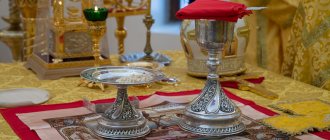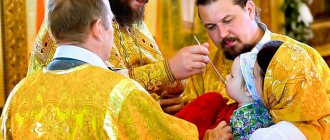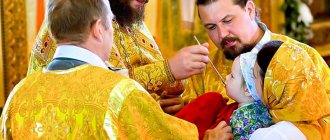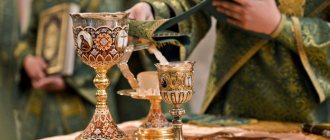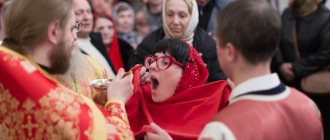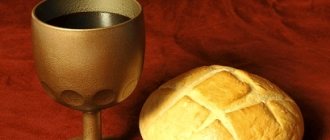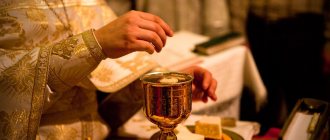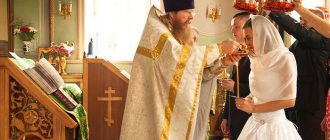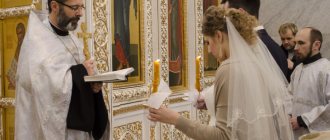In this article we will look at interesting information about the sacrament, the Sacrament of Communion. Let us examine in detail this ancient ritual, which has survived and is important even today.
Communion is a sacrament for the soul of a baptized and believing person. Each of us is haunted daily by temptations and sins that are difficult not to succumb to. Having realized your mistakes, mentally feeling the need for cleansing, the subconscious pushes you to go to Church to meet the Lord, ask for forgiveness, and confess. One must carefully prepare for this sacred Sacrament so that communion is aimed at cleansing the soul and body.
What is the Sacrament of Communion?
What is Communion? Communion is God's gift to people. The essence of the gift is the opportunity to be closer to Christ, to be with him as a friend in the closest relationship. The custom of eating prosphora with wine as a way of connecting with God is very ancient. Christ introduced the sacrament of communion on Maundy Thursday, the day before the crucifixion, 3 days before the Resurrection.
He established this sacrament at the Last Supper, that is, during the last dinner with the disciples. At that dinner he blessed the cup, bread and wine. At Communion they receive a piece of God - prosphora and wine, symbolizing the Body and Blood of the Lord himself. A custom has developed to let children go to the Chalice first, then men come up, and then women. They do not cross themselves near the chalice, so as not to accidentally touch it and knock it over.
Communion is a gift of God
What is important in the sacrament of Communion is the connection with God. By partaking of the Body and Blood of our Savior from a single Chalice, we thereby unite with each other. Prayer in the temple is an occasion to show a sign of your friendliness towards the friends of Christ. What Communion in church is can only be understood by attending it.
Now most people are baptized, but not enlightened, that is, they do not have basic knowledge about the faith, and especially about the Church Sacraments. But when a person does not participate in the sacraments of the Church, it is very difficult for him to resist those temptations and temptations into which his earthly turmoil constantly leads him. The human soul desires spiritual communication, but sometimes it is looking for it in the wrong place; it is looking for paradise, but is often mistaken in its search.
Sacrament of Communion (Eucharist)
The Eucharist was originally celebrated as follows.
1
. Jesus Christ took the bread into His Most Pure hands, raised His eyes to the mountain (that is, upward) and gave praise and thanksgiving to the Heavenly Father.
2
.
The Lord broke the bread into pieces and gave it to the disciples with the words: “Take, eat;
This is My Body, broken for you for the remission of sins “36.
3
. The disciples, having received Bread from the Lord, ate It.
4
. The Savior took the Cup of wine and, according to the apostolic tradition, dissolved it with water.
5
.
Having given thanks to His Father, Christ said to the disciples: “ Drink of it, all of you: this is My Blood of the New Testament, which is shed for you and for many for the remission of sins
.”37.
6
.
And they all drank from it
(Mark 14; 23).
The question of how the Teacher and disciples were positioned at the Last Supper is not discussed by the evangelists. But some conclusions about this can be drawn based on the context. You just need to keep a few facts in mind.
1
. The pattern according to which the tables were arranged for the supper was a “triclinium” - three tables standing in the shape of a horseshoe.
2
. In the time of Christ, it was necessary to recline at the table (on a special bed) on the left elbow in order to have the right hand free; in addition, the gospel parable (See: Luke 14; 7
11) indicates that the Jews observed the custom of occupying places in a certain sequence.
3
. It was only possible to leave before the end of the evening without disturbing anyone from certain places, since in most other places the students reclined “at the back of each other’s heads.”
4
. All the evangelists testify that Judas left freely, without waiting for the end of the supper, after the Lord gave him a piece of bread dipped in salt.
Based on these facts, it is natural to assume that those closest to Christ should have been His most beloved disciples and Judas. The Gospel texts do not contradict the version that three reclined closest to the Savior: John, Peter and Judas the Traitor.
Archimandrite Cyprian (Kern) writes on this occasion: “The most authoritative and historically correct Lagrange for us suggests this: John is at the right hand of the Lord, Peter most likely is at the right hand of John, Judas is close to the Lord, at the head of another row of reclining disciples, and so, so that he could easily leave without disturbing anyone. Lagrange considers all assumptions about other places simply idle and futile.”
In apostolic times
the Eucharist
remained a supper, although the ritual of the Easter supper was not performed for it, but its simpler forms were used: Saturday or even ordinary.
The Eucharist
celebrated in this form until approximately the middle of the 2nd century. There is evidence of this in Pliny’s letter to Trajan (between 111–113) about the Bithynian Christians.
After the Day of Pentecost, the new Christians constantly remained in the teaching of the Apostles, in fellowship and breaking bread and in prayers
(Acts 2:42).
History has preserved for us an account of the ancient ritual of the Eucharist,
which is given in the 9th and 10th chapters of the “Teachings of the Twelve Apostles” (Didache).
In the 14th chapter of this monument of the 1st - early 2nd centuries,
general instructions about
the Eucharist
: “On the Lord's day, that is, on Sunday, having gathered together, break bread and give thanks, having first confessed your sins, so that your sacrifice may be pure.
Let anyone who has a misunderstanding with his brother not come together with you until they are reconciled, so that your sacrifice is not desecrated. For the Lord said about her: in every place and at every time offer Me a pure sacrifice, for I am a great King, and My name is praised among the nations.” There is also the following instruction: “Let no one eat or drink from your Eucharist
, but only those baptized in the Name of the Lord, for the Lord said about this: do not give holy things to dogs.”
Just as there were various thanksgivings in the Hebrew Mishnah, so were they in the rite of the Eucharist.
1
.
Above the cup:
We bless You, Our Father, for the holy Vine of David, Your servant, Which You showed us through Your Servant Jesus. Glory to you forever.
2
.
Above the bread:
We bless You, Our Father, for the life and knowledge that You have shown us through Your Servant Jesus. Glory to you forever. Just as this bread was scattered over the hills and was gathered into one, so may Your Church be gathered from the ends of the earth into Your Kingdom. For Yours is the glory and power through Jesus Christ forever.
3
.
After the celebration of the Eucharist:
We bless You, Holy Father, for Your Holy Name, which You have instilled in our hearts, and also for the knowledge, faith and immortality that You have revealed to us through Your Son. Glory to you forever. You, Lord, Almighty, created everything for the sake of Your Name, gave people food and drink, and to us, through Your Son, You gave spiritual food and drink, and eternal life. We bless You for everything, especially because You are Almighty. Glory to you forever. Remember, Lord, Your Church, to deliver her from all evil and perfect her in Your love, gather her, sanctified (by You) from the four winds into Your Kingdom, which You have prepared for her. For Yours is the power and glory forever. May grace come and pass away from this world. Hosanna to the God of David. He who is holy, let him come, and he who is not, let him repent. Maran afa (Our Lord is coming). Amen. Let the prophets give thanks as much as they want.
By 150–155 years
refers to a detailed description of the order of the Liturgy, which is given in the Apology of the Holy Martyr Justin the Philosopher (2nd century).
The texts that have reached us set out the rite of the Eucharist
in connection with the Sacrament of Baptism and the celebration of the Lord's Day (Sunday). On Sunday, the Liturgy was performed as follows: “On the so-called day of the sun we have a gathering in one place of all those living in cities and villages; at the same time, the memorial notes of the apostles or the writings of the prophets are read, as much as time allows. Then, when the reader stops, the primate, through words, gives instructions and exhortations to imitate the good things he has heard. Then we all get up and say prayers.
When we finish the prayer, then bread, wine and water are brought, and the primate also offers prayers and thanksgivings as much as he can, and the people confirm, saying: Amen. Then follows the distribution to everyone and the communion of the Gifts, over which thanksgiving is performed, and to those not present they are sent through the deacons. Meanwhile, those who are sufficient and willing, each according to his own free will, give what they want, and what is collected is collected by the primate, and he has care for orphans and widows, for all those in need due to illness or for other reasons, for those in prison, for strangers who have come from afar , - generally cares for all those in need.
On the day of the sun we hold a meeting in this way, in general, because this is the first day on which God, having changed darkness and matter, created the world, and Jesus Christ, our Savior, rose from the dead on the same day, since He was crucified the day before day of Kronos; and after Kronos’ day, since this day is the day of the sun, He appeared to His apostles and disciples and taught them what we have now presented for your discretion.”
Thus, the Eucharistic meeting on Sunday, according to the testimony of Saint Justin, consisted
1) from reading the Holy Scriptures;
2) sermons;
3) prayers;
4) communion of the Holy Mysteries of Christ.
At the Eucharist,
the rite of which included the Sacrament of Baptism, there was no reading of Scripture and no sermon.
The word "Assembly" from approximately the middle of the 2nd century for several centuries was used as the name of the Eucharist
.
This is how Dionysius the Areopagite calls the Eucharist
in his book “On the Church Hierarchy” (late 5th – early 6th centuries).
However, the Eucharist
of the first times of Christianity was called by a variety of terms, such as: the Lord's Supper, the Breaking of Bread, the Offering, the Invocation, the Supper, the Lord's Table, Liturgy
(Greek
common cause), Anaphora
(Greek
offering), Agape
(Greek
love) ), Synaxis
(Greek
collection), etc.
After Pentecost, the number of those joining the Church completely coincided with the number of new participants in the Eucharistic Assembly. To be a member of the Church meant to participate in the Eucharist.
Remnants of the ancient Lord's Supper were widespread in the Alexandrian ecclesiastical district in the 4th and 5th centuries.
According to the testimony of Socrates Scholasticus (5th century), “Egyptians partake of the Holy Mysteries differently than Christians usually do: after they are full and eat all kinds of food, they partake in the evening, when the Offering is made.”
In other African Churches the Lord's Supper with the Sacrament of the Eucharist
was performed only on Maundy Thursday.
The Eucharist
on this day was celebrated in the evening, and they received communion after having already eaten. Nowadays in the Orthodox Church, a reminder of the ancient Christian Lord's Supper is the rite of raising the Panagia, when the Mother of God prosphora is distributed. Now this rite is performed only in monasteries.
According to Rule 50 of the Council of Carthage, Communion should only be on an empty stomach
. In the Ancient Church they communed separately the Body of Christ, which the priest gave to the communicant in hands folded crosswise, and the Holy Blood, which was taught by deacons from a common Chalice.
This practice existed even during the time of the Trullo (“Fifth-Sixth”) Council of 691. When they began to commune with both the Body and Blood of Christ is unknown. Rule 23 of the VI Ecumenical Council prohibits charging for Communion
.
Following the example given by the Lord Jesus Christ at the Last Supper, Communion
in the ancient Church it was performed after the breaking of the Eucharistic bread. Among the Greeks, the breaking of bread into four parts immediately followed the consecration of the Body and Blood of Christ; in other Churches this was done before the distribution of the Holy Gifts to those receiving communion.
In some other places in the East, bread was broken twice: into three parts after the consecration of the Gifts; and each of these three - into small parts before Communion.
The Mozarabs38 divided the bread into nine parts, each of which symbolized one of the events in the life of Jesus Christ.
Approaching Communion
in strict order: first the bishop, followed by the presbyters, deacons, the rest of the clergy, ascetics; then women - deaconesses, virgins and widows; then the children and everyone else present at the Liturgy.
In the Apostolic Decrees there is evidence that the Bishop himself distributed the Gifts, but in the time of Justin Martyr (that is, in the 2nd century), the bishop only consecrated the Gifts, and the deacons distributed them.
Subsequently, there was a practice of distributing Holy Bread by bishops and priests, and deacons served the Chalice of Wine to the communicants. Sometimes deacons, with the permission of the bishop, taught the Holy Sacrament to the laity under the supervision of the clergy.
At different times and in different Local Churches the order of Communion
clergy and laity differed in some details.
1
. In Spain and among the Greeks, only priests and deacons received communion at the altar; other clergy communed on the choir, and the laity on the pulpit.
2
. In Gaul, laymen and even women received communion in the choir.
3
.
The laity received communion standing or kneeling; presbyters - standing, but bowing to the ground before Communion
.
4
. The women received the Body of Christ in a special white cloth, after which they placed it in their mouths. According to the rule of the Council of Auxerre, a woman was forbidden to take the Body of Christ with her bare hand.
5
.
In the first centuries, the Holy Blood was sucked from the Chalice using a special gold or silver tube. However, there is an assumption that Communion
with the Holy Blood could be carried out directly from the large Chalice given by the deacon.
6
.
Until the 4th century, due to persecution of Christians, the faithful performed the Sacraments
in the catacombs and after
Communion
they took home the remaining particles of Holy Bread, with which they themselves received communion at home when they needed it (Justin Martyr, Tertullian, Cyprian of Carthage testified to this).
Saint Basil the Great wrote that in his time “in Alexandria and in Egypt in general, everyone, even a layman, has a vessel (koinonia) specifically for home Communion
, and receives communion whenever he wants.”
7
. In case of illness or other circumstances that prevented communion in church, a deacon, or a lower cleric, and sometimes even a layman would bring the Holy Gifts to the sick person at home. The faithful, according to the testimony of Gregory the Great, could take Them with them on a journey. Clergy and laity carried the Holy Gifts in a clean towel (oraria) or in a bag hung over the neck on a ribbon, and sometimes in a gold, silver or clay cup.
8
.
The 43rd rule of the Council of Carthage (397) prescribes communion
before eating, and the 6th rule of the Council of Macon (585) determined to excommunicate those elders who violate this rule.
How to prepare for Communion?
They don’t go to Communion without preparation. If a person is baptized, and at the same time he has no doubt that this is the Body and Blood of Christ, the Holy Gifts, the church still requires additional preparation from him. It consists of attending worship services and reading the Holy Scriptures.
On the eve of the day of communion, attendance at the evening service is required. This is a prerequisite for preparing for the Sacrament of Communion. At the end of the service or the next day, you need to confess your sins and receive pardon from the Lord.
Prayers should be said before communion
It is also important to fast for 3 to 7 days and not eat meat, fish, or dairy products. From the evening until the Sacrament, they refuse food and go to Communion on an empty stomach. During this period, you need to realize your mistakes, repent of what you have done, refrain from bodily pleasures, forgive and ask for forgiveness from the offended. Taking communion in hostility is a mortal sin. While preparing, the canons are read every morning and evening:
- prayer for sleep on the eve of communion
- repentant to our Lord Jesus Christ
- canon to the Guardian Angel, the Most Holy Theotokos
- following to Holy Communion
- morning rule before service
These prayers are a recommended list; it is difficult for a beginner to read and understand everything thoughtfully. Therefore, it is permissible to reduce the number to the required ten prayers, which consist of preparation for Holy Communion. But the abbreviation for Communion must be discussed with the priest after confession, since the required number of prayers must be selected personally for each person.
You should take communion regularly
It is quite difficult for children to follow all the rules of prayer in preparation for Communion. Parents need to determine the appropriate number of prayers that will be easy for the child to handle, then gradually increase the number of prayers. But the child’s faith does not depend on quantity; the main thing is to be able to explain why all this is needed and why it is so important. Parents explain to their children what Communion is in different ways. But they all agree on one opinion - the child will understand the Sacrament gradually and only under one condition, that faith in the family is not just beliefs, but manifests itself as a way of life.
Communion in church: what is it and why?
Communion is bread and wine, which, after a special prayer, “transubstantiation,” symbolizes the Body and Flesh of the Lord. The Lord left His Body and Blood to us at the Great Supper before His suffering on the Cross, as it is written in the Gospel.
And while they were eating, Jesus took bread, blessed it, broke it, and gave it to the disciples, saying, “Take, eat: this is My Body.” And, taking the cup and giving thanks, he gave it to them and said: drink from it, all of you, for this is My Blood of the new testament, which is shed for many for the remission of sins (Matthew 26:26-28)
“...do this in remembrance of Me” (Luke 22:19)
Communion is hidden from us in its true form and the image of bread and wine is preserved, since it is not common for man to consume flesh, even Divine flesh. But after transubstantiation, that is, after the completion of the sacrament, the property is changed - this is already the true Body and true blood of Christ.
The sacrament was created and introduced by the Lord Himself on the eve of the betrayal of Judas, immediately before the arrest, scourging and execution. Communion, which is consumed in the church, is a union with God the Father in Christ, reconciliation with Him for the sake of His Son. This is the New Testament between man and God, which the Savior brought to earth. Christ gave himself as a sacrifice so that we would eat His Body and drink His Blood and through this have eternal life within us, which was once lost in Paradise, as He told us in the Gospel.
Unless you eat the flesh of the Son of man and drink His blood, you will not have life in you. He who eats My flesh and drinks My blood abides in Me and I in him (John 6:53,56)
Communion in the Catholic Church is different from the Orthodox. So, the first one uses unleavened bread for the sacrament, and the second one uses yeast bread.
How does the Sacrament of Communion take place?
Children under seven years old go to Communion without confession. Adults must confess, telling the priest their sins, sincerely repenting. Confession is performed in churches either in the evening after the evening service, or in the morning before the start of the liturgy.
Confession usually takes place in a church with a large number of people, so you need to respect the secret of confession, not crowd next to the priest, and not worry the confessor who reveals his misdeeds to the priest. A servant of God asks about sins not for his own interest, but acts as a messenger from the Lord.
Liturgy is served in the church in the morning. Find out what time the service starts in a particular church, since everyone’s schedule is different. Liturgy is the main divine service, an amazingly beautiful sacrament that has deep content and meaning. It consists of ancient chants and is aimed at approaching Communion with prayers. The participants pray spiritually at this service and at the end reverently receive communion.
Liturgy takes place before communion
Married couples take Communion before an important step in their lives - accepting a marriage that is made in heaven, before the Wedding. Communion takes place a few days before the official celebration. In the evening before going to bed, they read prayers for communion. And in the morning, without eating food, they go to work. There is only one recommendation before the wedding - be sincere with each other, and God's grace will only bind loving hearts more tightly. Listen sensitively to the prayers read by the priest and pray with him. Only what is said by the priest and sung by the choir is important and necessary for many years of life together.
After Baptism, infants also need to receive communion. The child is obliged to live a spiritual life. If he does not receive communion, his soul may die, and the little man will grow up with a dead soul. Later he may be seized by an evil force, even to the point of mental illness, to the point of madness. And if this does not happen, a person with a not very kind disposition will simply grow up. If a child is given communion according to all the rules, then his soul lives and develops. She falls under the special protection of the Lord's grace. During Lent, infants receive communion only on Saturdays and Sundays.
Hands should be folded crosswise
So, how does the action itself take place? After the queue has lined up:
- fold your arms crosswise on your chest, right on top
- when it’s your turn to approach the priest, say your name and, opening your mouth, take a piece of prosphora with wine from the priest’s spoon
- after the assistants blot your lips with the linen, kiss the cup
- with the same position of your hands, without talking to anyone, go to the table for a drink and, after drinking it, take the prosphora
- After the ceremony it is worth listening to prayers of thanksgiving
How the Sacrament of Communion appeared - important facts from history
Photo: Pravlife.org
The fact that the Eucharist is the basis of the Divine Liturgy and an indispensable Sacrament for the salvation of the human soul is well understood not only by modern believers, because the first Christians also knew about this. As soon as Christianity entered a person’s life, they began to celebrate the Sacrament of the Eucharist, but everything looked a little different than we are used to seeing now. The first Eucharist celebrated was not called Communion, but “Agape” and the translation of this word had a very symbolic meaning, since it sounded like the supper of love.
It was at this evening that people read and interpreted the Holy Scriptures, and also praised the Lord by singing Old Testament hymns. The first Christians baked special bread called “Panagia” in honor of the Virgin Mary. Later they began to perform the rites of services recorded by famous saints of the church: Basil the Great, Gregory the Theologian, and also John Chrysostom.
As for other important historical facts relating specifically to the sacrament of the Eucharist, it is worth noting the following:
- the first division of agape began to be practiced in Byzantium, which turned into charitable meals for people who found themselves in difficult financial situations - they received a piece of the Eucharist itself;
- the hymns proclaimed aloud by the first Christians turned into secret prayers;
- over time, such concepts as small and great entrances appeared;
- priests practiced agape service in the evening, but performed liturgies in the early morning;
- gradually stopped using such practices as the withdrawal of penitents from their temple, as well as catechumens;
- a demarcation of the altar from the main part of the temple appeared, and after that the iconostases appeared, which we are accustomed to seeing in churches now;
- over time, priests began to use a spoon (a small spoon with a cross at the end of the handle) to give communion to the laity.
Gradually, such hymns began to appear as “The Trisagion”, “Creed”, “Only Begotten Son”, “Cherubic Hymn”, with which many modern Christians are well familiar. Gradually, services began to appear, performed in the morning and evening hours.
Why do you need to take communion?
Why do you need to take communion? The Sacrament of Communion prepares us both for the blessed resurrection and for the joyful meeting with Christ. It helps a believer get rid of bad thoughts and fight evil in everyday affairs. Transforms the spiritual world if there are problems in life, relationships with your soulmate, and it seems there is no way out of this situation. But if faith in God lives in your heart, then you need to go and turn to him through confession, Communion, so that he can suggest and lend a helping hand. The human soul is the creation of the Lord and it rejoices when it comes to its heavenly father through this ritual.
The Sacrament should be approached with great trepidation
It also happens that after visiting the sacrament a person does not become better, but quite the opposite, even worse than he was. What is the reason for this? It's all about attitude to what is happening. It happens that after the sacrament they boast about their feelings to each other, forgetting about the main essence of everything.
The essence of the Sacrament is not to experience delight, but to overcome yourself, your sins and passions with God’s support and become closer to the Lord and other people. It is important to remember that Judas also received communion, and this was his condemnation. Therefore, we will approach such an important sacrament with extreme responsibility in order to find the connection we are looking for.
Eucharist (communion): rules of preparation
Before coming to the Eucharist, you must fast for three days, during which you exclude the following foods:
- Meat,
- Dairy products,
- Eggs.
If you adhere to strict fasting, you should also abstain from fish. But despite these prohibitions, lean foods are allowed and should be consumed in moderation.
Spouses are advised to abstain from physical intimacy during fasting. You also need to remember that girls cannot receive communion on the days when they are menstruating. It should be noted that it is important to fast not only with the body, but also with the mind. There is no need to hold a grudge against loved ones; in case of any offense, you need to forgive them.
Fasting before communion can be relaxing for pregnant, breastfeeding and sick people. The ritual must be carried out strictly on an empty stomach.
Speaking about the participation of the faithful in the Eucharist, it must be said that it requires special preparation. Believers who are preparing for communion read three canons:
Repentant to the Lord Christ:
Let us sing a song of victory, crying out.
Chorus: Have mercy on me, God, have mercy on me.
Now I, a sinner and burdened, have come to You, my Master and God; I don’t dare look at heaven, only I pray, saying: give me, O Lord, understanding, so that I may weep bitterly for my deeds.
Chorus: Have mercy on me, God, have mercy on me.
Oh, woe to me, a sinner! I am the most damned man of all; there is no repentance in me; Give me, Lord, tears, so that I may weep bitterly for my deeds.
Glory to the Father and the Son and the Holy Spirit.
Foolish, wretched man, you waste time in laziness; think about your life, and turn to the Lord God, and weep bitterly about your deeds.
And now and ever and unto ages of ages. Amen.
Most Pure Mother of God, look at me, a sinner, and deliver me from the snare of the devil, and guide me on the path of repentance, so that I may weep bitterly for my deeds.
Prayer service to the Most Holy Theotokos:
Song 1
Irmos: Having passed through the water like dry land, and having escaped the evil of Egypt, the Israelite cried out: Let us drink to our deliverer and our God.
Chorus: Most Holy Theotokos, save us.
Contained by many misfortunes, I resort to You, seeking salvation: O Mother of the Word and the Virgin, save me from heavy and cruel things.
Chorus: Most Holy Theotokos, save us.
Passions trouble me and many despondencies fill my soul; die, O Young Lady, with the silence of Your Son and God, All-Immaculate.
Glory to the Father and the Son and the Holy Spirit.
Having given birth to You and God, I pray, Virgin, to be delivered from the cruel ones: for now, running to You, I extend both my soul and my thoughts.
And now and ever and unto ages of ages. Amen.
Sick in body and soul, grant the Divine visitation and providence from You, the only Godmother, as a good, good Mother.
Song 3
Irmos: O Supreme Creator of the heavenly circle, O Lord, and the Creator of the Church, Thou strengthen me in Thy love, the desires of the land, the true affirmation, the only Lover of Mankind.
Chorus: Most Holy Theotokos, save us.
I entrust the intercession and protection of my life to Thee, Virgin Mother of God: Thou feed me to Thy refuge, guilty of the good; true statement, the All-Singing One.
Chorus: Most Holy Theotokos, save us.
I pray, Virgin, to destroy the storm of my spiritual confusion and sorrow: You, O Blessed One of God, gave birth to the ruler of the silence of Christ, the only Most Pure One.
Glory to the Father and the Son and the Holy Spirit.
Having given birth to good and guilty benefactors, pour out riches of good deeds to all, for all you can, as you have given birth to the mighty one in the strength of Christ, O blessed One.
And now and ever and unto ages of ages. Amen.
Help me with fierce ailments and painful passions, O Virgin, to help me: for I know Your inexhaustible treasure, Immaculate, inexhaustible.
Save Thy servants from troubles, Mother of God, for we all run to You according to God, as an unbreakable wall and intercession.
Look with mercy, O all-sung Mother of God, on my fierce body, and heal the illness of my soul.
Canon to the Guardian Angel:
Song 1
Irmos: Let us praise the Lord, who led His people through the Red Sea, for He alone was gloriously glorified.
To Jesus: Lord Jesus Christ my God, have mercy on me.
Sing and praise the song, Savior, worthy of Your servant, the disembodied Angel, my mentor and guardian.
chorus: Holy Angel of God, my guardian, pray to God for me.
I am the only one lying in foolishness and laziness now, my mentor and guardian, do not leave me, perishing.
Glory to the Father and the Son and the Holy Spirit.
Direct my mind with your prayer, to do God’s commandments, so that I may receive remission of sins from God, and teach me to hate the evil ones, I pray to you.
And now and ever and unto ages of ages. Amen.
Pray, O Maiden, for me, Thy servant, to the Benefactor, with my guardian Angel, and instruct me to do the commandments of Thy Son and my Creator.
In addition to the prayers described above, it is also necessary to read the Proceeding to Holy Communion. It includes the canon for communion and special prayers. All these prayers and canons can be found in the Orthodox prayer book.
The best article for you, go to: Is it possible to eat fish during the Assumption Fast? When can you eat?
On the eve of the rite of the Holy Eucharist, it is necessary to attend the evening service. Many people will ask, why evening? - because the church day begins in the evening.
Who is prohibited from receiving communion?
Who is not allowed to receive Communion? The reason for a ban on communion for a certain period may be:
- a serious sin in which you need to sincerely and honestly confess and talk to a priest
- renunciation of Christ
- refusal to reconcile with a repentant offender
For unbaptized people, the sacrament will not be purification and unity with God. But, even if a person was baptized in childhood, but has lost faith or perceives Communion as a magical rite, or he has some other motives and considerations in this regard, then the church reminds that Communion in this case can not only ennoble and heal person, but may be to his detriment.
There are also prohibitions for communion
- Women should not receive communion on menstrual days.
- Women after childbirth are allowed to take communion only after the cleansing prayer of the fortieth day is read over them.
- Those who are late for the start of confession are not allowed to receive the Sacrament of Communion.
After performing such a sacrament, you should protect your soul and body from external negative influences. Many priests say that it is worth coming to the Sacrament at least once a month. This is how our soul will be cleansed. After all, long-term refusal of Communion can lead to distress of the soul.
The main points of the need for the ritual
The rite of the Eucharist can be divided into internal and external aspects. Each of them carries its own importance and conditions. The inner side includes:
- Necessity. There is an opinion among the holy fathers that demons are most afraid of baptism, communion and the cross. But it very often happens that people over time destroy the power of the grace of the sacrament, as a result of which demons can again begin to dominate a person. Therefore, communion is a mandatory rite, thanks to which a person receives reliable protection from evil spirits.
- Meaning and importance. The Eucharist helps us to more confidently overcome all the adversities and trials along the path of life. Gives you the opportunity to feel protected.
- Conditions under which the ceremony can be performed. The main condition is the Orthodox faith.
The best article for you, go to: Where does the soul of a suicide end up?
External parties include:
- Carrying out the ceremony itself. During which it is necessary to bow to the ground before the Holy Gifts.
- Frequency. You need to take communion at every major fast. And before fasts such as Christmas and Easter - twice.
- Preparation. Before coming to the ceremony, you need to undergo special training, the details of which will be described below.
- Adhere to correct behavior after the Eucharist. It is imperative to listen to prayers of gratitude and remain silent.
Repentance
One of the important moments of the entire ritual is repentance. It is performed in the Sacrament of Confession. There is an opinion that these two rites can be separated and communion can be started without confession. But in fact, this is more about Local Churches. Our Church has only just begun to recover from a spiritual catastrophe.
Compared to other countries, we have very few clergy and Orthodox churches. The life and spiritual level of modern believers is much lower compared to the life of the first Christians. Therefore, our Church strictly adheres to the practice of confession before communion. By the way, many priests consider repentance to be a second baptism. After all, just as baptismal water washes the soul from sins, so tears of repentance cleanse our soul.
Of course, sometimes you have to watch how someone close to you forces a person to go to this ritual. By forcing them, they make a huge mistake, because a person who does not carry faith within himself will not receive purification of the soul. For him it will be a mere formality. Therefore, a person must arrive at the celebration of the Eucharist on his own.
The best article for you, go to: What they bring to church for the funeral table
If you are undergoing the ceremony for the first time, then we recommend visiting a church or temple, approaching the priest and receiving his blessing.
The Lord is always with you!
Watch also the video about the Sacrament of the Eucharist:
